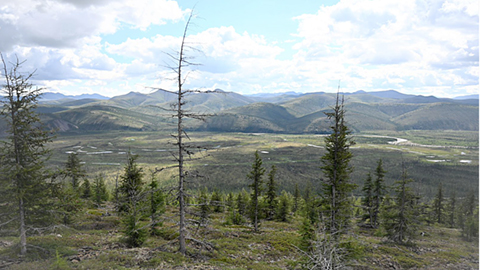Siberian Federal University: Tree Rings Report Climate Change in the North
SibFU scientists, as part of an international scientific group, have studied the temporal changes in the variations of stable isotopes of oxygen, carbon and hydrogen in the annual rings of coniferous trees in Subarctic regions.
Tree ring data show climate changes in the past and simulate future ones. The results of the study were been published in the Science of The Total Environment journal.
Boreal (or northern, from the ancient Greek βορέας — North) forests cover a huge area from 50° to 70° north. In northern Canada, central and north-eastern Siberia, large areas of boreal forest are overlapped by permafrost, which thaws and releases additional organic carbon into the atmosphere due to rising air temperatures.
Melting permafrost and uneven subsidence of rocks and soil due to thawing of underground ice make boreal forests extremely vulnerable to climate warming.
Previously, scientists found that boreal forest trees are very sensitive to climate change and are good at registering summer air temperature signals. However, since the 1990s, in some boreal regions of the American and Canadian subarctic, there was a decrease in the sensitivity of tree growth to summer air temperature. This could potentially be due to dry conditions, reduced precipitation, and increased air temperatures.
According to Olga Churakova, Dr.Sc. (Biology), leading researcher at the Ecosystem Biogeochemistry Laboratory, SibFU, changes in spring-summer air temperature affect the growth of trees in regions with a sharply continental climate, and information about these changes is recorded in tree rings.
“Tree growth is also influenced by other parameters such as rainfall, relative humidity, sunshine duration. These parameters can be recorded in isotope ratios of carbon (13С/12С), oxygen (18O/16O) and hydrogen (2H/1H) in tree rings. Based on these stable isotopes and the available climate data, it is possible to re-enact the climate of the centuries or millennia ago”, told Olga Churakova.
She explained that the combination of three stable isotopes in tree ring studies could provide a comprehensive description of climate variability in the boreal forest zone and improve the quality of temperature and ecohydrological simulations. The reliable and high-quality information about past climate change may give more accurate models of future climate change.
According to the scientist, the current temperature changes in Siberia differ by 4°C from the data of the pre-industrial period, while European chronologies and models predicted a deviation of 1.5–2.5°C. This indicates the need for an expanded description of climate parameters and enhancement of climate reconstructions that would improve the quality of climate models and forecasts.
The SibFU scientists have obtained comprehensive data on all three stable isotopes for the subarctic regions of Siberia and Canada. They are important for modelling of sunshine duration and relative humidity, as well as winter-spring temperatures, which can be extracted from tree growth rings.
According to the researchers, for more reliable forecasts, it is necessary to comprehensively study past climate changes. This will require both defining changes in air temperature and considering hydroecological characteristics, including the effects of permafrost in the subarctic of Eurasia.
The scientists explained that the melting of permafrost and the formation of thermokarst lakes can lead to the death of trees and the destruction of infrastructure. In addition, meltwater can be used by trees during warm periods of growth, which can be recorded in the isotopic ratio of the stable isotope of oxygen (δ18O) in tree rings.
Today, the scientific team’s task is to model three stable isotopes in tree rings for boreal forests located both inside (Siberia, Canada, Alaska) and outside of the permafrost zone (Finland, Sweden, Norway).
It is necessary to simulate the depth of thawing permafrost and assess the adaptive abilities of forest ecosystems to changing climatic conditions, as well as to identify triggers that lead to an increase in the lack of elasticity of water vapour and a decrease in the duration of sunshine over the past 1500 years. The scientists explain that stratospheric volcanic eruptions are one of such triggers.
The study was supported by the Russian Science Foundation (21-17-00006). SibFU is implementing the Centre for Low-carbon Development and Climate Policy strategic project within the framework of the Priority 2030 program.

